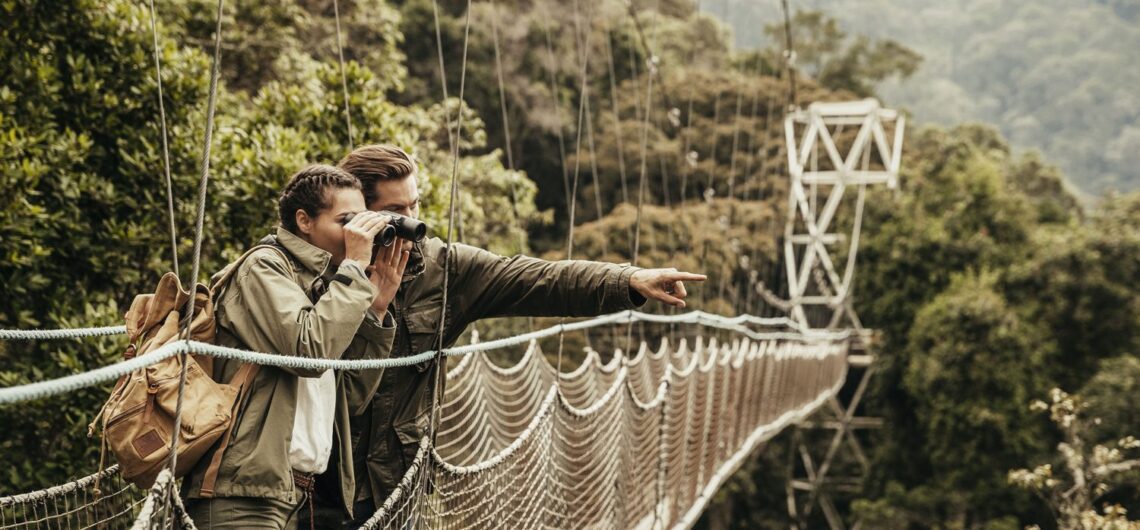The uniqueness about Canopy walk of Nyungwe in Rwanda: One of Rwanda’s top tourist attractions is the Canopy Walk in Nyungwe Forest. The Nyungwe Forests in Rwanda’s Western province are a must-see because of the rolling hills and tea plantations there. One of Africa’s oldest rainforests, Nyungwe Forests National Park is also one of its most magnificent and biodiverse. The mountainous area is teeming with fauna, including 12 different primate species, including the L’Hoest’s monkey, which is exclusive to the Albertine Rift, as well as a tiny colony of chimpanzees.
The uniqueness about Canopy walk of Nyungwe in Rwanda
Experience the rain forest from a breathtaking new perspective on the renowned Canopy Walkway, the only walk of its kind in East Africa, which hangs 60 meters above the forest floor between massive trees and towers, providing a breathtaking view of the flora and fauna, both below and above. This natural and living forests of Nyungwe is little gem of primates, including chimpanzees and mountain monkeys playing in the trees.
It is worthwhile to take the Canopy walk in Nyungwe of Rwanda. The Canopy walk of Nyungwe can begin at 8:00 a.m., 10:00 a.m., 7:00 p.m., or 3:00 p.m. This is a wonderful wonder to see if you’re not afraid of heights. It takes roughly two hours to travel from the starting point at the Uwinka Visitor Center to the canopy.
The Canopy Walk Bridge was situated 60 meters above the forest floor and connected two massive trees. Along with the crispness of the air and the breathtaking aerial view of the trees, you will adore the amazing birds that you will see while you stroll. Feel to book a trip with us to Rwanda where you can have the Canopy walk of Nyungwe.
You can engage in chimpanzee trekking, Colobus monkey tracking, or a visit to a local tea plantation (with a great opportunity for birding) while we’re in Nyungwe Forests National Park.The length, level of effort, and likelihood of sighting chimpanzees on the chimpanzee trek are all obviously uncertain.
The journey leads you up a steep but doable incline until you first hear and then witness a large group of chimpanzees having breakfast in a ficus tree. Finding a porter to assist with the subsequent rise and descent is advised, especially for older guests and others who have trouble walking. A short stroll next to a tea plantation allows visitors with lots of time to trek and see the Colobus monkeys.
Get to meet the troops of these beautiful creatures, you will witness dozens upon dozens climbing in the trees–some sitting sedately, and others actively leaping from branch to branch. A great highlight to tourists that visit Nyungwe Forest National Park. Unique sighting, a mother with a snow-white baby (they don’t develop their black and white fur until they’re older).
The Nyungwe forests’ canopy walk experience lasts for two hours and begins with a 200-meter walk along the forest trail beneath dense canopies to give participants a chance to see nature at ground level before they go on the canopy walk path to reach the forest’s highest point.
The monkeys, including the blue monkeys, L’Hoest monkeys, black and white Colobus, red-tailed monkeys, and birds, may all be seen from above. The minimum age requirement for this walk is six years old, and children must be accompanied by an adult. The welcome center will receive $60 from each participant for this activity. Even more so, the action lasts the entire year.
Remember to bring a raincoat because there is a good probability that it won’t rain. Additionally essential are the hiking boots, which can be rented at the reception area. The crutches are offered without cost. Plan to go gorilla trekking in Rwanda’s Volcanoes National Park or go on a safari to Akagera National Park to observe rhinos, elephants, buffaloes, lions, and enjoy a boat ride along Lake Ihema while surrounded by hippopotamuses and a variety of various bird species.


Comments